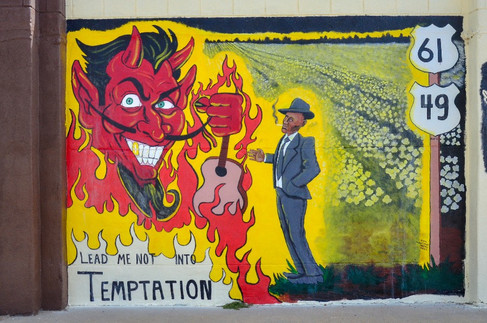Memphis: Where the South Meets Blues, and Elvis Is Still the King
- The Frequent-Fatigue Flyer
- Sep 23, 2024
- 7 min read
Updated: Dec 29, 2024
Exciting news! I recently had the incredible opportunity to embark on my first-ever journey to the South, a place I've never visited before. This year, I decided to dive headfirst into planning a thrilling "road trip" that kicked off in Memphis, where I indulged in all things Elvis, before venturing down to Louisiana. The adventure involved traversing through Mississippi, making meaningful stops that truly resonated with me.
Not only did I get to explore the legendary birthplaces of blues music, but I also delved into captivating aspects of American history that continue to captivate me. The southern United States boasts a rich yet challenging history, and I can't wait for you to experience or re-experience it through the pages of this article!
🤷♂️ What Took Me So Long To Get There? I’d never made it down South before, but then I met some fantastic friends from Memphis who had all the best stories about their hometown and the music-filled roads of the blues! They offered to give me the grand tour of Memphis, and then we’d take on the magic of New Orleans together. So, with their invitation and a lineup of legendary stops, it was finally time to pack up and head off on this Southern adventure!

Elvis: The King of Rock 'n' Roll Takes the World by Storm!
In the late forties, Elvis, at the age of thirteen, moved to Memphis with his family. Little did he know that he would be the one to introduce the small town in Tennessee to the world. By the time he turned 19, Elvis, with his guitar in hand, recorded some songs in one of the city's studios, and it only took him two years to release his first hit: "Heartbreak Hotel." It was at that moment that he, unknowingly yet, entered the history of music. I couldn't pass through Memphis without visiting Graceland, Elvis's home, which is the most visited house in the United States, alongside the White House.

Strangely, once inside, one realizes that the house is not as huge as one might have thought! Certainly, it is a magnificent colonial-style mansion, but Elvis's living room is not much bigger than my own living room, and the kitchen or dining room are quite ordinary (!). You can visit numerous rooms that are, obviously, still decorated in a 1950s style, and throughout the visit, one can imagine how Elvis lived surrounded by his loved ones in this house.


Some rooms are, I must admit, original and oversized like the "Jungle Room" with a green jungle carpet, tropical plants, and stuffed gorillas (!); downstairs, the yellow bar and lounge (really yellow!) with three TVs, or the room where Elvis and his friends played billiards with walls entirely covered in curtains (quite impressive!).

The first floor, where Elvis's bedroom and bathroom are located, are not open to visitors out of respect for Elvis and have never been opened to the public. Visitors can then explore the gardens, see the stables (Elvis loved horses!), the gym (he had a racquetball court built), the pool (which is nothing special), and most importantly, visitors can then go to a part of the garden (the memorial garden) where Elvis, his parents, and his brother are laid to rest.

On the other side of the street, across from Graceland, you can continue the visit and access immense buildings where you can admire a whole bunch of items, stage costumes, gold records, Elvis' cars, copies of his contracts, and so on. There are even Elvis' planes on site that you can also visit. It's a vast estate and you can easily spend the whole day "reliving" Elvis! I particularly enjoyed the room with all his stage costumes.
Back at the center of Memphis, if you still want a bit more of Elvis, it is possible to have lunch at his favorite restaurant. Elvis always sat in the same spot... I, of course, stopped there, had lunch, and obviously took the photo.... click.
At the city center and a stone's throw away from this restaurant is another historical place worth a visit: the Lorraine Motel, where in 1968, Martin Luther King was assassinated in front of his room, room 306. The motel is no longer operational but has become an annex of the Civil Rights Museum. Two cars from the 1950s-60s are parked in front of the motel to evoke the period in question, and a huge wreath of flowers is always displayed on the balcony in front of room 306.


Turning around, you can also see the building and the window from which the gunshot was fired, and this building is now also part of the museum. Unfortunately, I didn't have time to visit this museum, and I will return to Memphis just for that.

It is also in Memphis that I was able to see the Mississippi River for the very first time, and it is possible to cross the river by walking or biking across the Harahan Bridge, to have a view of the city of Memphis... but also to go from the state of Tennessee to the state of Arkansas on the same bridge (or have one foot in Tennessee (TN) and the other foot in Arkansas (AR). It's not the adventure of the century, but it's still not so bad, and, moreover, this metal bridge is beautiful (Big River Crossing).
After spending a few days in Memphis, it is time to hit the road and head further south towards Louisiana. But before reaching New Orleans, we explore the state of Mississippi.
Exploring the Roots of Blues Music in Mississippi: The Legacy of B.B. King
One might think that there is not much to discover in Mississippi... yet it is in this state that the blues was born, thanks in large part to the monumental talent of B.B. King. It is possible to visit the "B.B. King Museum" and pay respect to the King of the blues himself, as he rests in the small town of Indianola (his grave is next to the museum dedicated to him). The blues is a genre of music associated with the southern United States.
This sound, born in the late 19th century, originated from the black population and the exploited workers in the southern part of the country. The blues literally emerged in the cotton fields. As slaves worked tirelessly without being able to speak to each other, they found a way to communicate by emitting sounds, cries, and murmurs that repeated and slowly turned into small melodies. In the 1960s, as numerous uprisings of the black population occurred in the country, such as Rosa Parks refusing to give up her seat on a bus to a white person and the murder of Emmett Till in the state of Mississippi, which is considered one of the events that triggered the civil rights movement in the United States, the blues experienced a resurgence in popularity in the country.
But it is mainly thanks to singers like B.B. King and the rise of radios that the blues became known worldwide. B.B. King (whose first name is actually Riley, with the initials B.B. standing for Blues Boy) was born in Indianola, Mississippi, and it is in this small village that the B.B. King Museum was built (very well designed!) and where the artist rests (right next to the museum).
Back on the highway, at the intersection of Route 49 and 61, is the place (supposedly) where Robert Johnson, the musician considered a talent of the blues, especially "Delta Blues" with instruments like guitar and harmonica, is said to have sold his soul to the devil in exchange for guitar-playing abilities. Quick photo stop.
The crossing of the state of Mississippi to reach Louisiana also goes through a not very touristy place that I absolutely wanted to see: the village of Money, which is one of the locations on the "US Civil Rights Trail" (or the "Civil Rights Trail" in the United States, which includes several important locations and events that led to the anti-discrimination law as we know it today) where a young African American, Emmett Till, aged 14, was murdered during the summer of 1955. Emmett Till is from Chicago and is on vacation with his cousins in Money, Mississippi. One day, he goes to a small grocery store (Bryant grocery store) to buy candy along a road.

Once inside the store, the owner, Carole Bryant, 21 years old, accuses the young boy of flirting with her, whistling at her, and even touching her. A few days later, the young Emmett is kidnapped by two men, tortured, and murdered, then thrown into the nearby river. A few months later, an all-white jury acquits the two men who will never be convicted of the murder, even though they confess to killing Emmett and sell their story to a newspaper for $4,000. This murder (and the acquittal of the two killers) is one of the catalysts for the birth of the civil rights movement in the United States. The Civil Rights Act (or the federal law against all discrimination) was passed by the U.S.
Congress nine years later, in 1964. There is nothing left of the grocery store along this road, but you can stop to see the plaque in memory of Emmett Till. As you continue driving, you pass by cotton fields, reflecting on the cruel and difficult past of the southern states of the United States. We will reach Louisiana after spending a night in the small town of Greenwood. Around Greenwood, we make some stops where the movie "The Help" (2011) was filmed, and it seems that Emma Stone, Viola Davis, and the entire film production stayed at the hotel where we slept (The Alluvian Hotel). #slept_perhaps_in_the_same_bed_as_emmastone
The Quick Recap (Too Long To Read Edition)
🌟 What Was The Highlight Of My Trip? Learning about the rich history of blues at the B.B. King Museum (seriously, it's a must-see!) and gaining some serious southern cred by hitting up key spots that shaped American history.
📅 How Many Days? Three days at least for Memphis and Mississippi, and even then, I barely scratched the surface of what I wanted to see. But, Memphis and Mississippi are a little... out there. They're not exactly on the way to anywhere else, so be prepared for some detours. If you're doing a road trip, it's smart to either tack on New Orleans down south (like I did with my 7-day adventure) or swing by Nashville on the east (which I’ll be doing next time, because who doesn’t need more country music in their life?).
⚡ Energy Level For This Adventure? Not too tiring (thankfully!), I survived without turning into a puddle of exhaustion. It’s a leisurely pace, really like a slow waltz through history, with a few pit stops for fried chicken and blues. If you can handle a couple of hours in a car, hopping between museums and southern hotspots, you’re good to go. It’s more "relaxed road trip" than "endurance challenge," but be prepared to pack on the calories (hello, fried food) and still have enough energy to pretend you're a blues legend by the end of the trip!

































